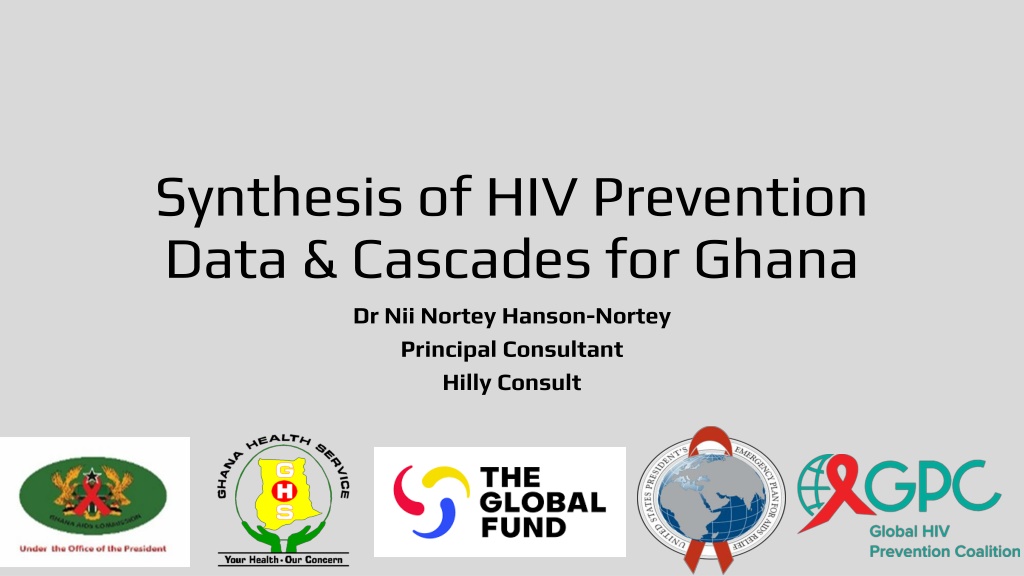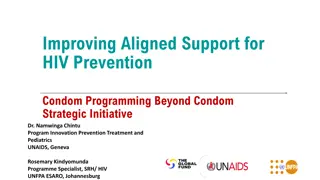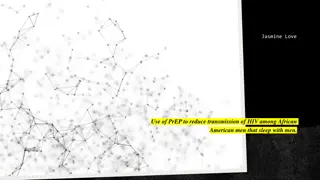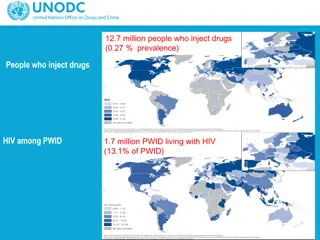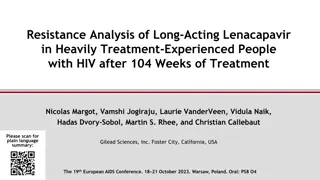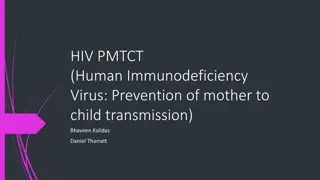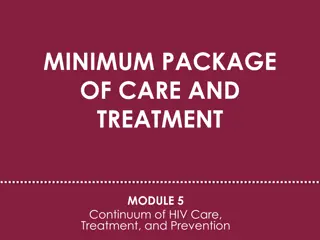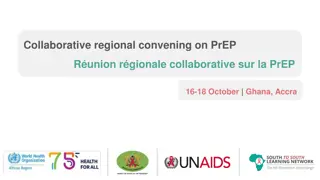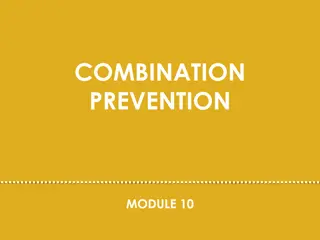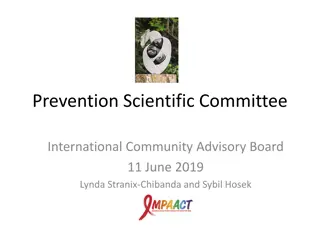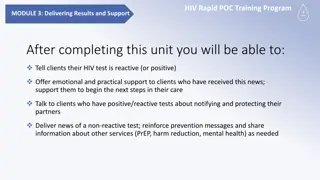Comprehensive Overview of HIV Prevention Strategies and Interventions
This synthesis covers the importance of monitoring progress in HIV prevention through data cascades, the need for standardized frameworks, promoting effective HIV prevention programs in diverse social contexts, and the key pillars of combination HIV prevention strategies. It also outlines various HIV prevention intervention classes, including behavioral, biomedical, and structural interventions.
Download Presentation

Please find below an Image/Link to download the presentation.
The content on the website is provided AS IS for your information and personal use only. It may not be sold, licensed, or shared on other websites without obtaining consent from the author. Download presentation by click this link. If you encounter any issues during the download, it is possible that the publisher has removed the file from their server.
E N D
Presentation Transcript
Synthesis of HIV Prevention Data & Cascades for Ghana Dr Nii Nortey Hanson-Nortey Principal Consultant Hilly Consult
Where Are We? Treatment cascade (or care continuum) is one method for monitoring progress in preventing secondary transmission There is no similar, uniform, framework yet for monitoring progress in HIV primary prevention programme implementation. Several HIV prevention cascade approaches have been proposed Data used have been focused on prevention methods and population groups in specific settings around the world. There is growing consensus that some standardization would be useful for accurately measuring and comparing the success of prevention programmes and for monitoring progress to meet global HIV prevention targets.
Promoting HIV Prevention HIV prevention programmes must: Operate in social contexts that affect their ability to reach those most at risk and to provide appropriate services to them. Provide enabling environment for the uptake of prevention interventions not only availability of individual HIV prevention services. Be focused on, accessible to, and taken up by the people most at risk of acquiring infection (primary prevention). Prevent onward transmission of HIV (secondary prevention), through ART care to achieve undetectable viral loads. Be monitored using methods that can provide timely and actionable information. HIV prevention interventions are complex because of differences within at-risk populations, periodicity of risk, and overlapping risks and vulnerabilities for individuals and populations. So, one size does not fit all .
The Five Pillars of Combination HIV Prevention Pillar 3 Pillar 5 Pillar 4 Pillar 1 Pillar 2 Key Populations Combination prevention and harm reduction packages for and with ARV-based Prevention Pre-exposure prophylaxis (PrEP), post-exposure prophylaxis (PEP), treatment as prevention including for elimination of vertical transmission. Condom Programming Promotion and distribution of male and female condoms as well as lubricants. Adolescent Girls & Young Women Combination prevention packages in settings with high HIV incidence (based on differentiated, layered packages). Adolescent Boys & Men Combination prevention packages in settings with high HIV incidence (including voluntary medical male circumcision and promoting access to testing and treatment). Sex workers Gay men and other men who have sex with men People who inject drugs Transgender people Prisoners
HIV Prevention Intervention Classes Behavioral Interventions: Applied to promote change in sexual behaviour, and to increase HIV service utilization and adherence to HIV services and behaviours educational activities to address knowledge, attitudes, risk perception, norms, HIV service demand and skills. Biomedical Interventions: The use of medical treatments such as ARVs for prevention or post-exposure prophylaxis, barrier methods such as male and female condoms, medical male circumcision or other methods to reduce the chance of transmission of HIV. Structural Interventions: Effecting policy or legal changes; enabling environmental changes; shifting harmful social and community norms; changing systems of care and/or power structures; catalyzing social and political change; and empowering communities and groups to reduce HIV acquisition and transmission.
Value of Cascades Though complex to develop, these cascades do have multiple potential (and sometimes overlapping) uses, including: Informing programme management and improvement by analyzing bottlenecks; Assessing progress toward prevention goals (sub-national, national, and ultimately global); Generating research questions (e.g., about why gaps in coverage and uptake are occurring); Supporting advocacy for sustaining or expanding prevention services to ensure effectiveness; and Providing transparency about how prevention funds are being spent and with what effect at the service provision level. Prevention cascades provide a tool for monitoring progress in HIV prevention programmes implementation and should be complemented by other data analysis efforts to obtain a detailed understanding of the overall state of HIV prevention within a population.
Difference between Treatment & Prevention Cascades Treatment Cascade Antiretroviral treatment (singular option) Prevention Cascade Multiple interventions (each as single intervention, but preferably in combination) with different frequencies (daily or non-daily oral PrEP), event driven (condoms, needles and syringes), and with varying efficacy and acceptability/preference At risk HIV negative individuals, e.g., living in a high incidence area and/or part of a population group at high risk, and/or with specific individual risk/vulnerability factors When at high risk (individuals can move in and out periods of risk over time/life course) Core intervention All people living with HIV Population in need Always Intervention timing
Data Sources Survey Data IBBSS (2019) and GMS III (2023) Population size estimates for FSW and MSM based on 3 source capture recapture (3SCRC) method in surveys Condom use with last client/partner & consistent condom use Programme Data Reports from implementors on numbers of KPs reached Programme reach, peer contact, condom distribution PreP interventions Combination prevention interventions
The HIV Prevention Cascade Target Population: The total focus group population (100%). Reach/Coverage: Percentage of the focus population reached/covered by the prevention method(s). Uptake/Use: Percentage of those who are reached/covered by the prevention method(s) who are actually taking it up/using it. Correct/Consistent Use: Percentage of those who are taking it up/using it, who are correctly/consistently using the prevention method(s). E.g. the largest gap is in the uptake/use of the prevention methods.
Interpreting the HIV Prevention Cascade Is the picture being seen plausible given what is generally known about HIV prevention for this focus population? Identify the gaps and think about why the gaps identified between the different cascade steps occur? Based on the reasons for gaps identified, what possible solutions should be sought and tested? NB: What denominators are being used? What is the difficulty in measurement. Capturing consistent use may be difficult when data comes from different sources What other things may be going on in the environment besides the prevention programme being monitored that may contribute to outcomes that might erroneously be attributed to that prevention programme
National FSW Prevention Cascades
FSW Condom 2023 FSW PreP 2023
National MSM Prevention Cascades
MSM PreP MSM Condom
National TGW Prevention Cascades
National TGW Condom National TGW PreP
JSI MSM PreP JSI FSW PreP
MSM PreP Sub-National Cascades by Regions Major Drivers Bono Region Ashanti Region
Greater Accra Region Northern Region
FSW PreP Cascade by Regions Major Drivers Ashanti Region Bono Region
Greater Accra Northern Region
FSW PreP Cascades Monitoring PreP Uptake JSI Supported Regions (Western, Western North and Ahafo National (GAC Aggregate)
Gaps Identified Population estimates for KPs needs regular updates National level cascades hide a lot of detailed information & sub-national cascades reveal the intervention gaps to be addressed at level of service delivery Access of KPs to PreP services is generally low across the country and limited to specific regions Monitoring and reporting PreP use among FSWs need to be intensified Quality of engagement on PreP uptake at subnational levels needs to be improved Number of condoms distributed is not equal to number of persons receiving and using condoms Data quality issues number of persons vs number of attendances especially among FSWs; Access to services by clients does not disaggregate to individual client episodes. There is no differentiation between client encounters and total client events accessing care Supply of condoms has experienced some challenges in recent times WAPCAS provided KP specific data on various interventions. Data collected as a part of the package of services provided does not synchronise number of persons reached with the number of condoms distributed number of condoms/ packs of condoms
Recommendations KP populations in the regions should well delineated Intervention approaches should be reconsidered Unique identification needed for FSW given their highly mobile status Standard indicators for prevention should be agreed to ensure data collected reveal robust implementation outcomes when used to develop the cascades. Gaps identified in outcomes in the various cascades should be discussed with all stakeholders and appropriate action taken to resolve them programmatically Methods of collecting service data at points of service delivery should be improved for interventions such as condom utilization. This could be done through anonymous exit surveys using electronic tablets at the end of each service delivery visit. Programme implementors and Ghana Health Service should collaborate with the private sector to estimate condoms distributed through their outlets such as from pharmacies. This activity should be conducted annually and preferably using service delivery data to reflect the true state of outcomes of interventions being implemented.
Acknowledgements Ghana AIDS Commission (GAC) National AIDS/STI Control Programme (NACP) The Global Fund for AIDS, TB & Malaria (GFATM) President's Emergency Plan for AIDS Relief (PEPFAR) Global HIV Prevention Coalition (GPC) West Africa Program to Combat AIDS and STI (WAPCAS) FHI360 John Snow Inc. (JSI) Hilly Consult Team
